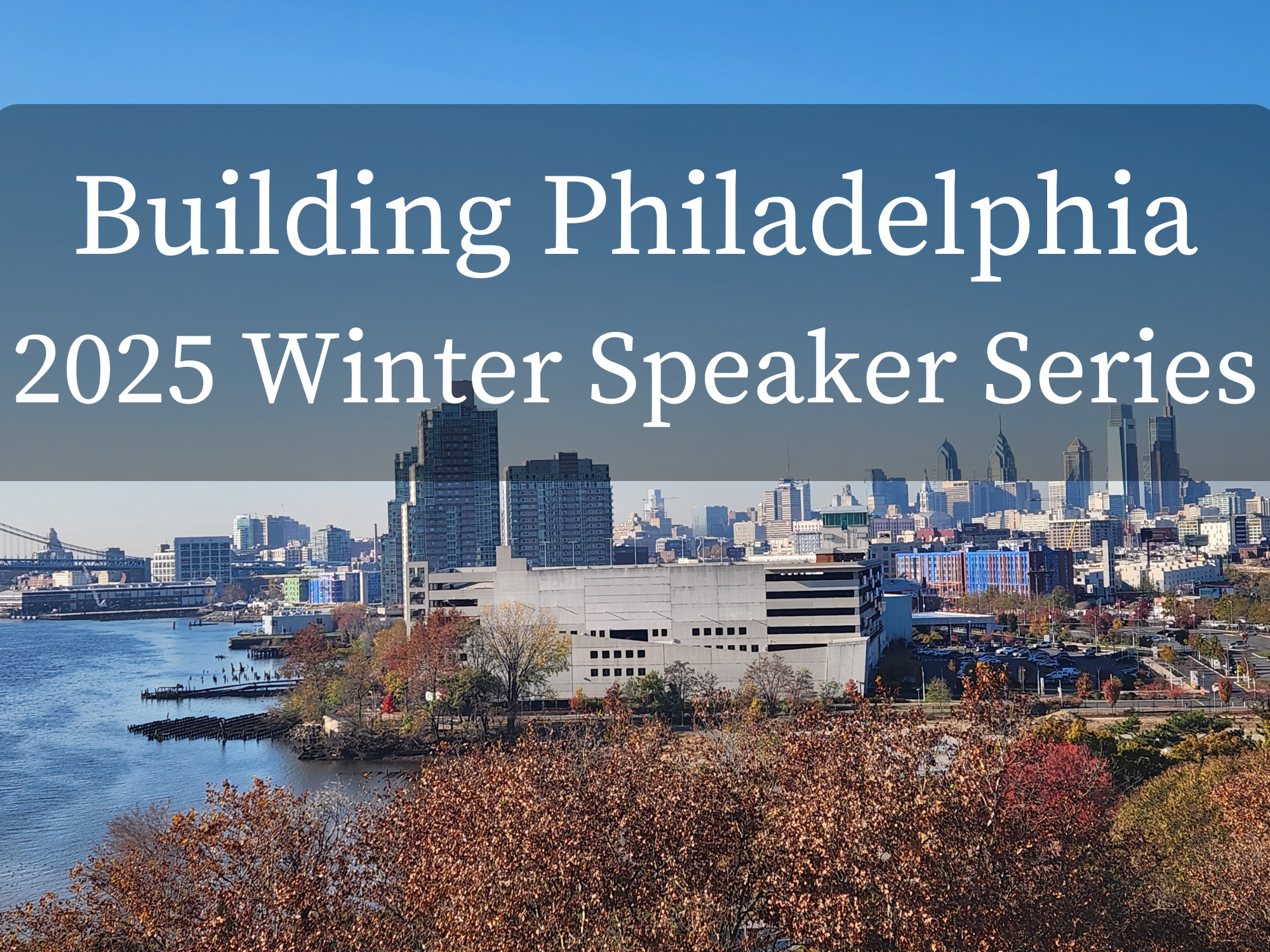Enjoy the Whole Series
Register for all 8 presentations in the Winter Speaker Series and don’t miss a lecture. (To register for one or more individual presentations, click on “show individual events” on the series registration page.)
View our bookstore for a list of book recommendations by our speakers this season!
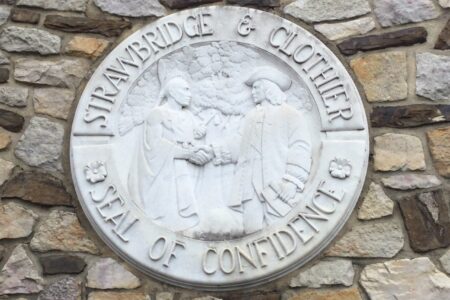
Off To Market (Street)
January 14, 2025, 6 — 7:30 PM
Presented by Michael Lisicky John Wanamaker, Strawbridge & Clothier, Gimbels, Lit Brothers, Snellenburgs. Take another trip down Market Street and revisit these great emporiums that once defined Philadelphia’s mighty shopping thoroughfare. Each of these five businesses catered to specific clienteles and each department store played important roles in the city’s cultural fabric, with their special
Register HerePresented by Michael Lisicky
John Wanamaker, Strawbridge & Clothier, Gimbels, Lit Brothers, Snellenburgs. Take another trip down Market Street and revisit these great emporiums that once defined Philadelphia’s mighty shopping thoroughfare. Each of these five businesses catered to specific clienteles and each department store played important roles in the city’s cultural fabric, with their special promotions and traditions. Hear some stories behind each of these retailers and learn some fun little-known facts. Come “Meet Me at the Eagle” and remember “The Store for Thrifty People,” hear how “Nobody, but Nobody Undersells Gimbels” and recall your “Great Store in a Great City.” The talk guarantees my “Seal of Confidence.”
Michael Lisicky is regarded as one of the country’s foremost retail historians and has written several historical books on department stores, such as Wanamaker’s, Gimbels, Bamberger’s, Filene’s and more. He has presented lectures at the New York Public Library, Historical Society of Pennsylvania, Boston Public Library, New York Fashion Week, and Wanamaker Centennial Week, in addition to appearances on CBS Sunday Morning, BBC World News, and the History Channel. A former contributing retail writer at Forbes.com, Lisicky’s commentary has been featured in publications such as the New York Times, Wall Street Journal, Washington Post, and the Philadelphia Inquirer.
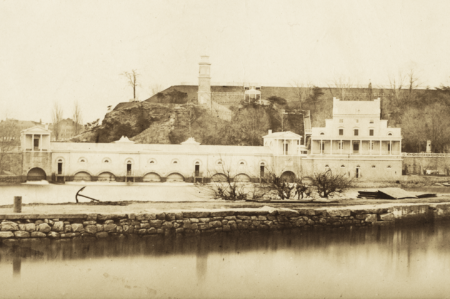
Illustrated History of the Fairmount Water Works
January 21, 2025, 6 — 7:30 PM
Presented by A. Leonard Pundt The Fairmount Water Works was once the most visited place in America after Niagara Falls. Many famous people stopped there and left a record of their impressions. When and why was this famous Philadelphia landmark built? What problems was it meant to solve? Why was it shut down? How has
Register HerePresented by A. Leonard Pundt
The Fairmount Water Works was once the most visited place in America after Niagara Falls. Many famous people stopped there and left a record of their impressions. When and why was this famous Philadelphia landmark built? What problems was it meant to solve? Why was it shut down? How has it come to be preserved? Does it have current and future value? Explore these and other questions as Mr. Pundt walks us through the Water Works’ fascinating history, lavishly illustrated with an abundance of images.
A. Leonard Pundt is a member of the Oliver Evans Chapter of the Society for Industrial Archeology. As a research consultant for the Philadelphia Water Department, Len recently edited and greatly expanded a comprehensive history of the Fairmount Water Works, originally begun by the late Jane Mork Gibson, that he is hoping to have published. A former Air Force officer and teacher, he previously lived in Philadelphia for over twenty years and currently resides in Lebanon, Pennsylvania, with his wife and two children.
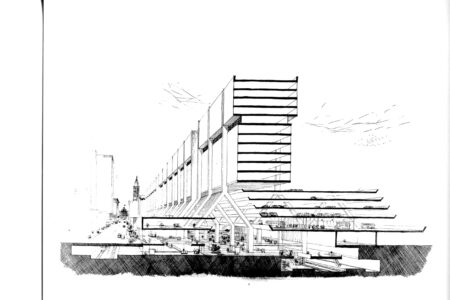
Revitalizing East Market Street: A History 1957-2024
January 28, 2025, 6 — 7:30 PM
Presented by John Andrew Gallery The revitalization of East Market Street and the construction of the commuter rail tunnel were Philadelphia’s most expensive urban renewal projects in the late 20th century. The planning of the project extended over 25 years before the second and final phase was completed. During that period many prominent architects contributed
Register HerePresented by John Andrew Gallery
The revitalization of East Market Street and the construction of the commuter rail tunnel were Philadelphia’s most expensive urban renewal projects in the late 20th century. The planning of the project extended over 25 years before the second and final phase was completed. During that period many prominent architects contributed to the development of the projects, including Louis Kahn, Romaldo Giurgola, Skidmore Owings and Merrill, Gerald Cope, and John Bower. When opened, The Gallery at Market East was for a time the most successful urban shopping center in the country.
John Andrew Gallery began his career in Philadelphia in 1964 working with Edmund Bacon at the City Planning Commission. He was responsible for the 1964 design of the Market East Project. In 1976, he became the first director of the Office of Housing and Community Development and in 1978 chairman of the board of the Market East Development Corporation. In that capacity he oversaw the design and developer negotiations for phase 2 of The Gallery at Market East. He is the author of the guidebook, Philadelphia Architecture a guide to the city.
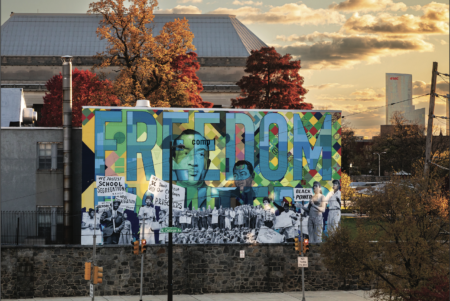
Black History in Philadelphia Landscape: Preserving Christian Street
February 4, 2025, 6 — 7:30 PM
Presented by Amy J Cohen In this richly illustrated presentation, author Amy Jane Cohen will examine the many ways in which history is acknowledged in our built environment. Her talk will focus on the historical importance of Christian Street in the Black Philadelphia experience. She will describe the history of the First African Baptist Church
Register HerePresented by Amy J Cohen
In this richly illustrated presentation, author Amy Jane Cohen will examine the many ways in which history is acknowledged in our built environment. Her talk will focus on the historical importance of Christian Street in the Black Philadelphia experience. She will describe the history of the First African Baptist Church and efforts to save the building from demolition. She will also look at the successful campaign to create the Christian Street/Black Doctors Row Historic District. This talk has been developed explicitly for the Preservation Alliance, so people who have heard other book talks by Amy Jane Cohen are encouraged to attend.
Amy Jane Cohen spent twenty years as a middle and high school social studies teacher. In 2013, she became the Director of Education at the film company History Making Productions, where she developed educational materials to accompany documentaries, mostly about the history of Philadelphia. Amy produced Octavius V. Catto: A Legacy for the 21st Century which won a Mid-Atlantic Emmy Award for Historic/Cultural Program Feature. Amy is a frequent contributor to Hidden City. Her first book Black History in the Philadelphia Landscape: Deep Roots, Continuing Legacy was published by Temple University Press in 2024.
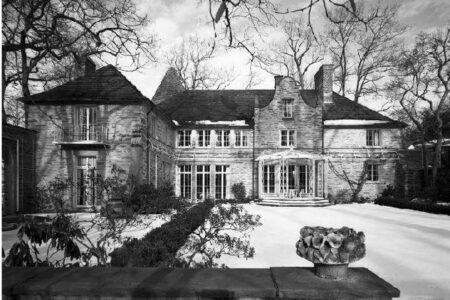
The Wissahickon Arts & Crafts Style :Analyzing And Defining A Regional Architecture
February 11, 2025, 6 — 7:30 PM
Presented by Spencer Rubino Northwest Philadelphia, and the neighboring environs of Montgomery County and Delaware County, encompass a unique cultural identity. This identity is expressed through the regional architecture that was forefronted by developer Dr. George Woodward and the residential architects of the neighborhood around St. Martin’s Episcopal Church in Chestnut Hill at the turn
Register HerePresented by Spencer Rubino
Northwest Philadelphia, and the neighboring environs of Montgomery County and Delaware County, encompass a unique cultural identity. This identity is expressed through the regional architecture that was forefronted by developer Dr. George Woodward and the residential architects of the neighborhood around St. Martin’s Episcopal Church in Chestnut Hill at the turn of the twentieth century. These architects’ blending of medieval and renaissance country house elements using Arts & Crafts ideals created a unique interpretation of residential architecture that should be recognized alongside other regional styles in Philadelphia and given accurate nomenclature to define it. This presentation will argue for “Wissahickon Arts & Crafts” to be the defining term for these dwellings, based on evidence given in this presentation.
Spencer Rubino graduated from Thomas Jefferson University with his Bachelor of Architecture in 2022 and Master of Science in Historic Preservation in 2024. Spencer has assisted in the nomination of the PoweltonVillage and Washington Square West Historic District, as well as theC.Delores Tucker Residence in Mt. Airy. Spencer interned for Powers & Company and Richard Grubb & Associates, learning how to work in the various aspects of Federal and State Historic Tax Credit, as well as the Section 106 process. Spencer currently works as a project coordinator for Heritage Consulting Group. Spencer’s Master’s thesis analyzed and highlighted a unique regional architectural style present in Northwest Philadelphia, arguing for the nomenclature “Wissahickon Arts & Crafts style” to define these dwellings.
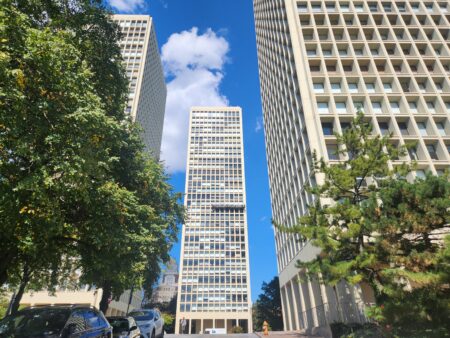
I.M. Pei’s Society Hill Towers at 60: The Legacy of Urban Renewal
February 18, 2025, 6 — 7:30 PM
Presented by Steve Baron The Society Hill Towers are marking their 60th anniversary as a neighborhood landmark, with three 31-story Modernist concrete towers rising over low-rise colonial Society Hill. This talk willtrace the evolution of Society Hill, from the early site of the Free Society of Traders, to the mid-20th century site of the Washington
Register HerePresented by Steve Baron
The Society Hill Towers are marking their 60th anniversary as a neighborhood landmark, with three 31-story Modernist concrete towers rising over low-rise colonial Society Hill. This talk will
trace the evolution of Society Hill, from the early site of the Free Society of Traders, to the mid-20th century site of the Washington Square East Urban Renewal Area and the present day.
In the 1960s, Ed Bacon, the Director of the City Planning Commission, and emerging Chinese-American architect I.M. Pei teamed up to redevelop the aging Dock Street Market. Together, they led the preservation and restoration of colonial-era row houses and added the Society Hill Towers, new row houses, and neighborhood greenways. Pei also drew inspiration from his childhood visits to his family’s ancestral classical gardens in Suzhou, China. Society Hill’s redevelopment transformed the neighborhood, and became a nationwide symbol of how urban renewal could be largely a force for good. Society Hill continues to evolve, with the development of the Park at Penn’s Landing, and plans for the Korean War Memorial park.
Steve Baron is an urbanist who grew up in and currently lives in the Society Hill Towers. He is currently a Geographic Information Systems (GIS) Analyst for the City’s Department of Aviation, and a member of the Central Delaware Advocacy Group (CDAG) and Association of Philadelphia Tour Guides (APT). Steve holds a Bachelor’s degree in Journalism and Urban Studies from New York University, and a Master’s degree in GIS from Temple University.
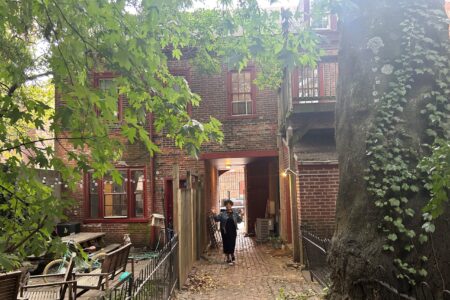
Uncovering Underground Railroad and Important Black History Locations
February 25, 2025, 6 — 7:30 PM
Presented by Morgan Lloyd and Michiko Quinones The 1838 Black Metropolis project focuses on reviving the memory of the Black histories of Antebellum Philadelphia. As the Philadelphia grid has stayed relatively stable, and due to historical preservation efforts, many of the homes of Black Philadelphians of the era that are mentioned in primary historical documents
Register HerePresented by Morgan Lloyd and Michiko Quinones
The 1838 Black Metropolis project focuses on reviving the memory of the Black histories of Antebellum Philadelphia. As the Philadelphia grid has stayed relatively stable, and due to historical preservation efforts, many of the homes of Black Philadelphians of the era that are mentioned in primary historical documents and archives remain standing. This includes William and Letitia Still’s home, leaders of the Underground Railroad. This talk will discuss how we have used the primary sources such as history books, newspapers, estate papers, wills, city directories and minute books from historical archives to pinpoint houses that served as Underground Railroad sites and the location Beneficial Hall, which was burned down in a mob attack.
Morgan Lloyd is a public historian, genealogist, artist, co-founder, and President of 1838 Black Metropolis. A proud descendant of the Nanticoke-Lenni Lenape tribe, her work explores the nuances of Black and Brown histories through art, space, and identity. She is the recipient of numerous civic awards and fellowships from institutions, including Montclair University, The Studio Museum in Harlem, and a Mellon curatorial fellowship at the Philadelphia Museum of Art. She also serves as Programming Coordinator at the African American Museum in Philadelphia, where she educates visitors through curated events, workshops, and tours.
Michiko Quinones is a public educator and public historian in Philadelphia. She is the co-founder and Director of Public History and Education of the 1838 Black Metropolis. She has been a docent for over a decade at both the African American Museum in Philadelphia and the Rosenbach museum. She holds a BA in African American Studies/Government from University of Maryland-College Park, and a Masters in Museum Studies from Harvard University. Her true love and focus of study is the Black community of the antebellum in Philadelphia. In this vein she has been resurfacing the achievements of this community through various formats; walking tours, online exhibitions, blogs, papers, lesson plans, conference presentations, public talks.
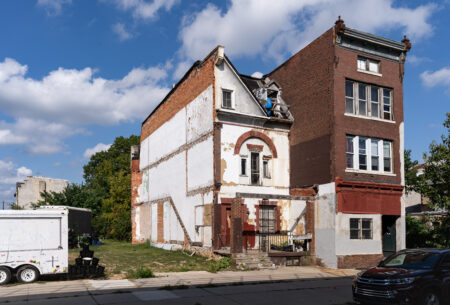
Building Ghosts: Past Lives and Lost Places in a Changing City
March 4, 2025, 6 — 7:30 PM
Presented by Molly Lester and Michael Bixler “Building ghosts” are the idiosyncratic remnants or imprints of demolished buildings, left behind on the sides of neighboring structures. Mostly seen in older Northeastern cities with rowhomes or party-wall adjacencies, they can reveal remarkable things, such as an old staircase going up the side of a building or
Register HerePresented by Molly Lester and Michael Bixler
“Building ghosts” are the idiosyncratic remnants or imprints of demolished buildings, left behind on the sides of neighboring structures. Mostly seen in older Northeastern cities with rowhomes or party-wall adjacencies, they can reveal remarkable things, such as an old staircase going up the side of a building or plaster traces left by a set of shelves in an attic gable. As history in our changing cities is erased and remade, these ghosts can be ephemeral or enduring. They can be quickly revealed and replaced in a neighborhood seeing rapid change or unveiled and never re-covered in a neighborhood that has not seen new construction in a long time. For this event, author Molly Lester and photographer Michael Bixler will discuss their new book, Building Ghosts: Past Lives and Lost Places in a Changing City (Temple University Press, November 2024) and the ghosts that reveal new truths and provocations about the changing city.
Molly Lester is a historian of the built environment, and currently serves as the Associate Director of the Urban Heritage Project at the University of Pennsylvania’s Weitzman School of Design. Her research interests include the ephemeral traces of “building ghosts” in the built environment and the role of women in shaping the American built environment in the 19th and early 20th centuries, with particular focus on architect Minerva Parker Nichols (1862-1949) and the She-She-She Camps of the New Deal. She is the author of Building Ghosts: Past Lives and Lost Places in a Changing City (Fall 2024, Temple University Press) and the co-author of Minerva Parker Nichols: The Search for a Forgotten Architect (2024, distributed by Yale University Press).
Michael Bixler is the Editorial Director and Chief Photographer of Hidden City of Philadelphia. His writing and photography is focused on creating dialogue and documentation of the built environment and how it relates to history, culture, and the urban experience. Bixler is the photographer of Building Ghosts: Past Lives and Lost Places in a Changing City (Fall 2024, Temple University Press).
Photo Credit: Michael Bixler
